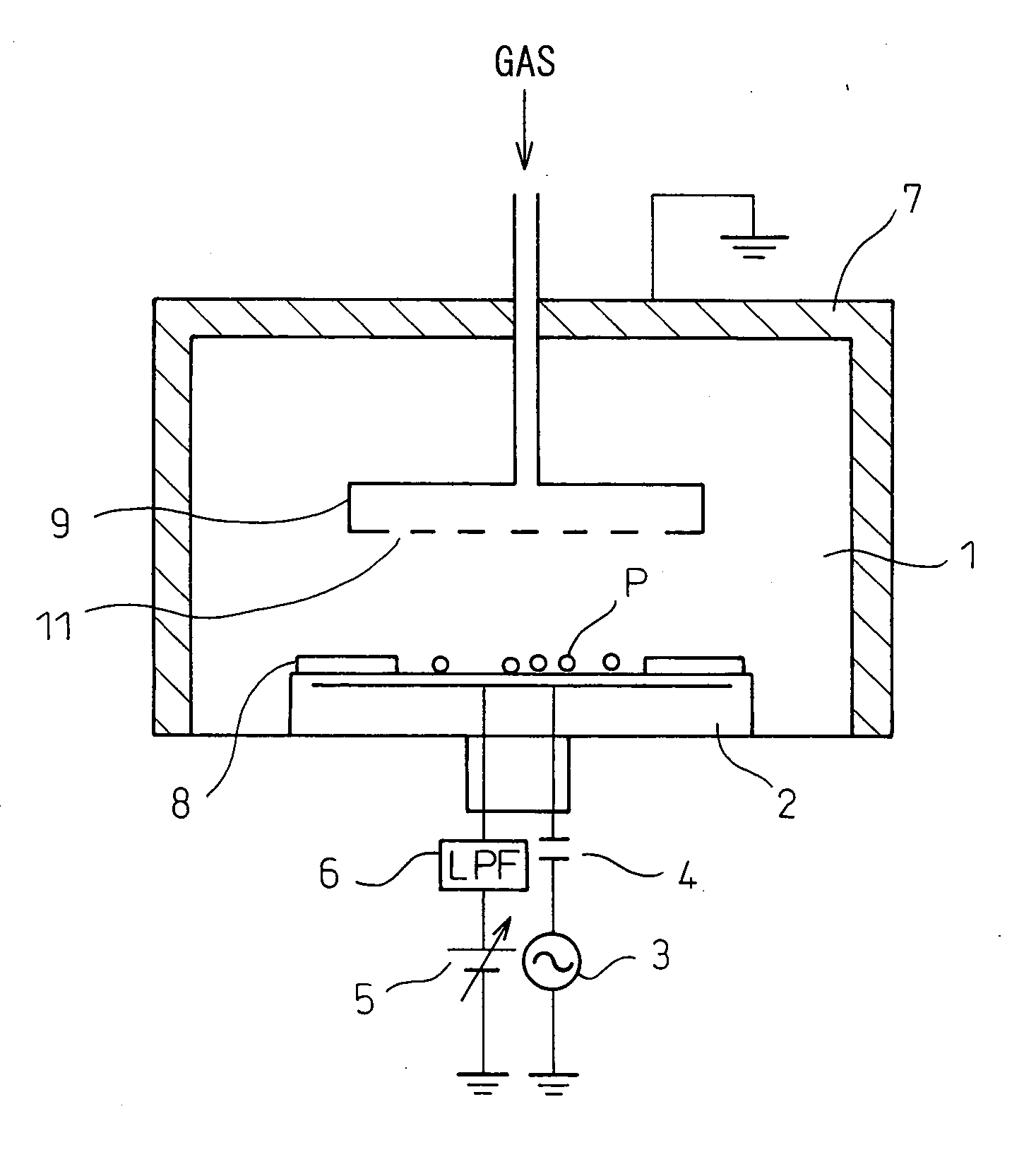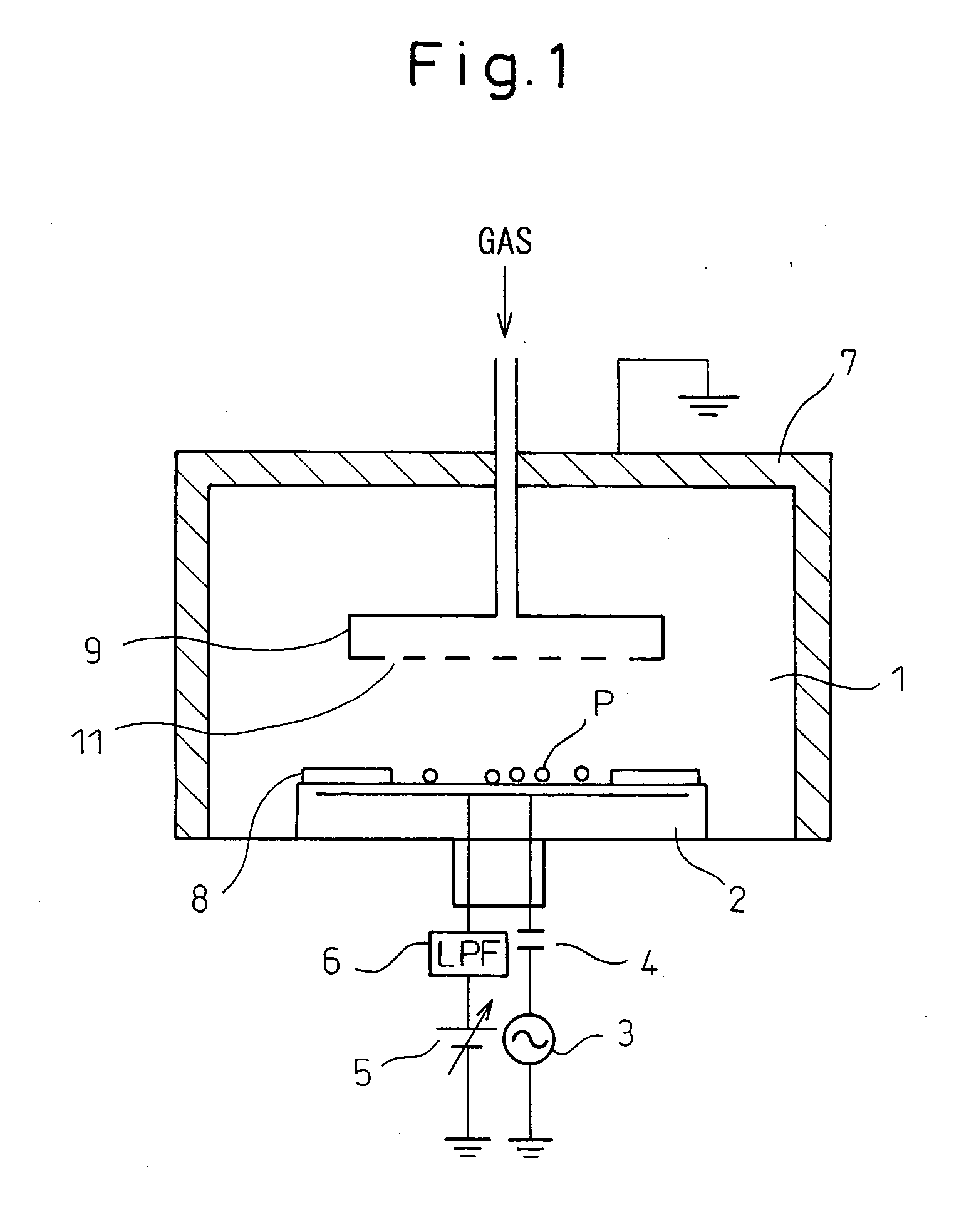Method for cleaning elements in vacuum chamber and apparatus for processing substrates
a vacuum chamber and element technology, applied in the direction of cleaning using liquids, chemistry apparatus and processes, electric discharge tubes, etc., can solve the problems of reducing the production yield of the finally produced semiconductor devices, reducing the efficiency of removing particles with a brush scrubber or a wiper blade under reduced pressure, and causing the effect of causing
- Summary
- Abstract
- Description
- Claims
- Application Information
AI Technical Summary
Benefits of technology
Problems solved by technology
Method used
Image
Examples
embodiment 1
[0055] In this embodiment, in case where there is a large difference between the permittivity of the stage surface and the permittivity of the particles, a predetermined electric field is formed on the surface of the stage in accordance with the second term of Maxwell's stress equation, and the particles are caused to scatter by the resulting repelling force.
[0056] More specifically, before the substrate to be processed is placed on the stage, a positive or negative voltage is applied to the stage by an electrostatic power supply unit such as shown in FIG. 1. An electric field appears at the surface via a dielectric on the surface of the stage. The strength of the electric field at the surface of the stage is considered to depend on the permittivity and thickness of the dielectric on the surface of the stage but, according to an experiment, a voltage approximately equal to the applied voltage appeared, and the strength of the electric field did not suffer attenuation due to the pre...
embodiment 2
[0063] When utilizing the difference between the permittivity of the stage surface and the permittivity of the particles as described in the first embodiment above, the effect can be further enhanced by coating the stage surface with a material having permittivity sufficiently larger than that of the particles expected to stick to the surface. Generally, in an environment where the stage surface is likely to be contaminated by the stick of silicon particles, a greater effect can be obtained if the stage surface is coated with a material having permittivity sufficiently larger than 11.
[0064] Examples of such materials include Bi2O3 (permittivity 18.2), CuO (permittivity 18.1), FeO (permittivity 14.2), KH2PO4 (permittivity 46), KIO3 (permittivity 16.85), PbBr2 (permittivity>30), PbCl2 (permittivity 33.5), PbCO3 (permittivity 18.6), PbI2 (permittivity 20.8), Pb(NO3)2 (permittivity 16.8), PbO (permittivity 25.9), PbSO4 (permittivity 14.3), SrSO4 (permittivity 18.5), TiO2 (permittivity ...
embodiment 3
[0065] In the first embodiment, the forces acting on the particles are exerted throughout the application of the voltage but, as previously shown in FIG. 3, the number of scattered particles greatly increases when the voltage changes (in particular, the instant that the voltage is applied). To utilize this phenomenon, a voltage of rectangular waveform may be applied repetitively to the stage. By so doing, the particles can be efficiently caused to scatter as the voltage is applied and stopped. Since it is the change in voltage that serves to promote the scattering of the particles, the waveform need not be limited to the rectangular waveform, but any other waveform, such as a pulse waveform or a sine waveform, may be used.
[0066] The reason is believed to be that particles easier to scatter are scattered at the first application of the voltage and the particles remaining to be scattered are given another change to scatter when the applied voltage is temporarily removed and the volta...
PUM
| Property | Measurement | Unit |
|---|---|---|
| pressure | aaaaa | aaaaa |
| pressure | aaaaa | aaaaa |
| pressure | aaaaa | aaaaa |
Abstract
Description
Claims
Application Information
 Login to View More
Login to View More - R&D
- Intellectual Property
- Life Sciences
- Materials
- Tech Scout
- Unparalleled Data Quality
- Higher Quality Content
- 60% Fewer Hallucinations
Browse by: Latest US Patents, China's latest patents, Technical Efficacy Thesaurus, Application Domain, Technology Topic, Popular Technical Reports.
© 2025 PatSnap. All rights reserved.Legal|Privacy policy|Modern Slavery Act Transparency Statement|Sitemap|About US| Contact US: help@patsnap.com



